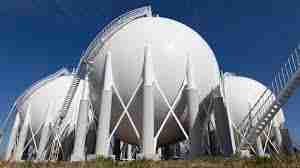The natural gas storage market is undergoing rapid development amid growing global energy demands, energy transition efforts, and strategic reserve initiatives. Natural gas storage has evolved from a backup system into a vital element of modern energy infrastructure. Governments and energy companies alike are investing in advanced storage solutions to ensure grid stability, price efficiency, and emergency preparedness. As new technologies, geopolitical risks, and environmental concerns reshape the market, development efforts are intensifying across all regions.

Market Description
Natural gas storage refers to the containment of surplus gas in underground or above-ground facilities for later use. These storage systems include:
Depleted oil and gas fields: Cost-effective and widely used due to existing infrastructure.
Salt caverns: Ideal for fast injection and withdrawal.
Aquifers: Often used when other options are limited.
LNG tanks: Above-ground facilities used to store liquefied natural gas before regasification.
Storage is essential for addressing seasonal demand fluctuations, absorbing supply shocks, and supporting long-term energy planning. The development of new facilities and the modernization of existing ones is crucial for maintaining energy security in an increasingly volatile global landscape.
Current Development Landscape
1. Growing Demand for Flexible Energy Systems
One of the strongest drivers of storage market development is the rising demand for flexibility in energy systems. Natural gas plays a pivotal role in bridging supply gaps caused by intermittent renewable energy sources such as solar and wind. As electricity grids become more dependent on variable energy, natural gas storage provides much-needed stability, particularly during peak consumption periods or renewable energy underperformance.
This increasing reliance on flexibility is encouraging the development of hybrid energy systems with integrated gas storage capacity.
2. Accelerated LNG Infrastructure Expansion
The liquefied natural gas (LNG) segment is growing rapidly due to surging global demand, especially in Asia-Pacific and Europe. With more LNG terminals under construction, corresponding development of storage infrastructure is also accelerating. Storage tanks for LNG are being built alongside import/export terminals, floating storage regasification units (FSRUs), and other offshore and onshore facilities.
This trend is particularly significant in countries like China, India, and Germany, where diversification of energy sources is a national priority.
3. Strategic Reserves and Policy-Led Initiatives
Several countries are implementing policies to establish or expand strategic gas reserves. The need for energy security, especially in the wake of geopolitical tensions, has prompted governments to fast-track storage development. In the European Union, new rules require member states to maintain minimum storage levels, leading to new facility construction and capacity expansions.
Similarly, the U.S., Japan, and South Korea are investing heavily in gas reserves, promoting development through regulatory incentives, subsidies, and public-private partnerships.
4. Technological Advancements in Storage Solutions
The development of the natural gas storage market is also being fueled by technological progress. Innovations in automation, AI-based predictive analytics, digital monitoring, and smart infrastructure are transforming how storage facilities operate. Key developments include:
Automated control systems for precise gas flow management.
IoT sensors for real-time pressure and leak monitoring.
AI models to predict peak demand and schedule injections or withdrawals accordingly.
These technologies not only increase safety and efficiency but also reduce environmental impact by minimizing methane emissions.
Regional Development Trends
North America: The U.S. leads with mature underground storage systems but continues to invest in digital modernization and LNG-export-driven expansions.
Europe: Storage development is being driven by EU energy independence strategies, with a focus on interconnectivity between member states.
Asia-Pacific: The most dynamic growth region, where rising LNG imports and industrialization fuel robust storage infrastructure development.
Middle East & Africa: Development is in early stages, with a focus on supporting domestic gas supply and enabling future export capabilities.
Environmental Considerations and ESG Alignment
As environmental, social, and governance (ESG) criteria become central to investment decisions, the development of greener storage infrastructure is gaining momentum. Operators are incorporating emissions-reduction technologies and adhering to stricter environmental standards. Facilities are also being designed with hydrogen compatibility to future-proof investments as the world moves toward decarbonization.
Sustainability-focused storage development not only reduces environmental risk but also attracts climate-conscious investors and financial institutions.
Challenges in Market Development
Despite favorable trends, there are several challenges impacting the pace of storage infrastructure development:
High capital requirements and long return-on-investment periods.
Complex regulatory environments in emerging economies.
Land acquisition and environmental approvals, especially for underground storage.
Public resistance in some areas due to safety or ecological concerns.
Addressing these challenges requires coordinated efforts among governments, regulators, investors, and communities.
Conclusion
The natural gas storage market is in a dynamic phase of development, driven by global energy shifts, policy mandates, and technological advancements. From ensuring seasonal supply security to supporting renewable integration and advancing national strategic reserves, gas storage is now a cornerstone of resilient energy infrastructure. With new projects launching across continents and modernization transforming legacy systems, the development outlook for natural gas storage is strong, sustainable, and strategically essential for the future of global energy.




